Dark chocolate, dogs, and adventure are just some of Mel's…
Apolinario Mabini has long been one of the underrated national heroes of our country. He finally gets some of the recognition he deserves thanks to the retelling of his life in Mabining Mandirigma, a steampunk musical by Tanghalang Pilipino. The musical runs this month at the Cultural Center of the Philippines. Even if you’re not an avid fan of musicals, this well-made, entertaining, and inspiring musical is a must-watch for everyone, and not just for students or teachers. If you’ve ever yawned in history class, this musical should rev up your senses since it’s a feast for the eyes and has splendid music for your ears. And there’s something for the heart as well, with its message of not giving up on our country and the determination to be a better Filipino.
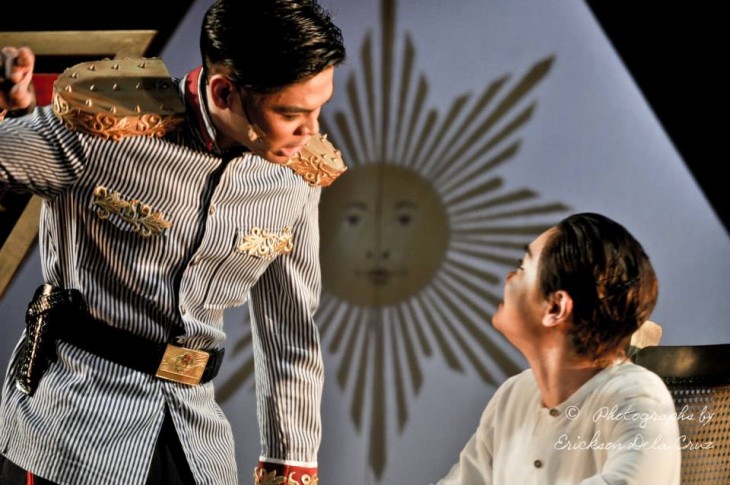
Turning History into Musical Theater
Mabining Mandirigma focuses on Mabini’s life as adviser of Aguinaldo’s government after the June 12, 1898, declaration of independence. They assemble the revolutionary government, and Aguinaldo creates a congress, where Mabini becomes chief minister. The new government is threatened not just by American colonizers, but also by ilustrado members of congress. After some decisions over which Aguinaldo and Mabini disagree, with Aguinaldo siding with the ilustrados and eventually accepting autonomy under American rule, the two part ways and Mabini resigns from Aguinaldo’s government. Mabini is captured by the Americans, rejects offers of amnesty, and instead helps the revolution. If you know remember your history, you’ll know he is exiled to Guam for two years, where his health deteriorates, and he finally signs the oath of allegiance to the United States so he can come home and die in his native country.
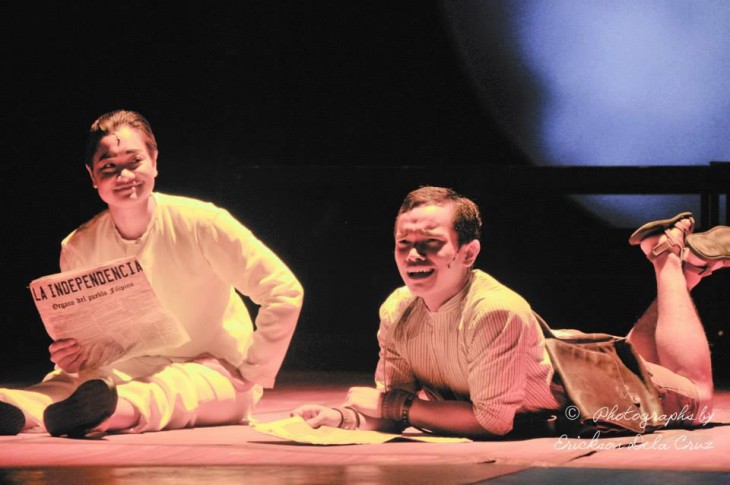
It’s impressive how Mabining Mandirigma turns political intrigue and even the dark moments of a national hero’s life into a musical, and one with great songs at that. Composer Jed Balsamo was able to create musical themes with very catchy melodies and inspiring lyrics. Traditional music was mixed with other styles to modernize the play.
Warning: Spoilers after this line!
As for the story, the pacing was just right, and there were hardly any dragging parts; theater-goers will be riveted by the performances and be engaged by what will happen to Mabini, Aguinaldo, and the Philippines, even if they have a general idea of how the story will go. The musical was a good mix of dark, dramatic moments, especially when Mabini has his hallucinations while he is sick, and even comedic ones, especially in the scenes featuring the character Pepe, Mabini’s imagined assistant. Through Pepe, audiences get an idea of what life was like for the lower classes and the uneducated during those times.
Stunning Visuals and Costumes
The set design by Toym Imao was striking and sent a powerful message to the audience. Upon entering the theater, audiences will see the backdrop consisting of metal gears framing the stage. Aside from being part of the musical’s steampunk theme, the gears also serve as symbol of the revolutionary movement of the Filipinos.
Throughout the musical, memorable figures like the life-size bust of Uncle Sam and Lady Liberty appeared, both haunting and impressive due to scale and symbolism. Imao also created an intricately designed carriage for Mabini as he passes on to the afterlife. It served as a grand and happy way of presenting Mabini’s “ever after.”
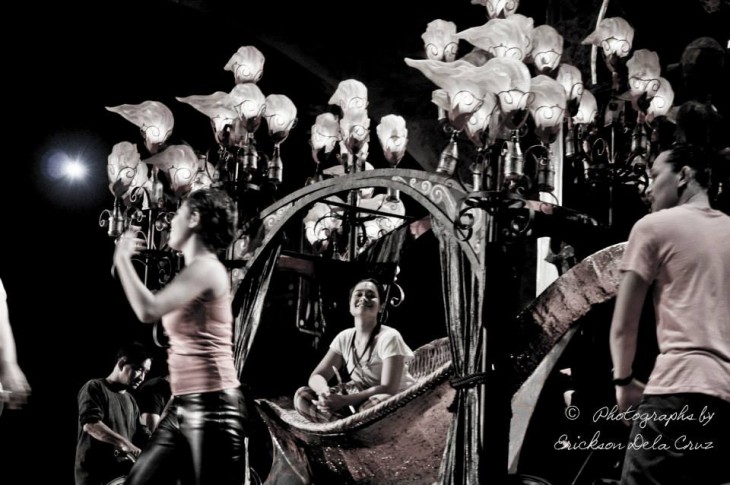
Being a steampunk musical, Mabining Mandirigma’s cast members were clad in traditional costumes that had been “steampunked.” Traditional Filipino wear was redesigned using a lot of color black material, as well as metal elements like studs and, of course, some rockin’ boots. Actors sported colorfully dyed and elaborate hairstyles. Looking somewhat like the costumes from Sweeney Todd, all these worked well against Imao’s stunning sets.
Inspiring Performances from a Stellar Cast
Being a musical, Mabining Mandirigma delivered very well on the singing front. Arman Ferrer, the actor playing Emilio Aguinaldo, was regal and commanding and showed massive talent with his exceptional singing. His is probably the singing that will stay with you after the show. You might never have imagined thinking of Emilio Aguinaldo as an attractive (or okay, cute) guy or a great singer, but with this musical, you may just have to rethink your impressions of our first president. It might have helped that Ferrer has played the roles of dashing leading men like Cinderella’s Prince Charming in the past. While he is able to play the good guy side of Aguinaldo, Ferrer also portrayed Aguinaldo’s dark side effectively here.
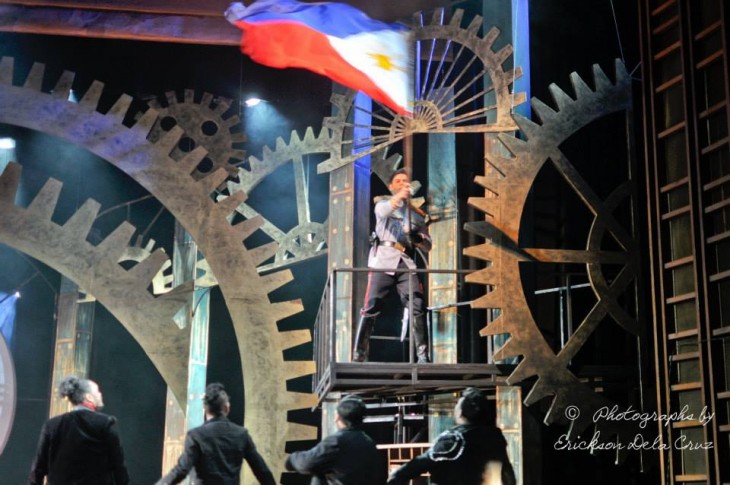
On the other hand, there was a fragile quality to Delphine Buencamino’s portrayal of Apolinario Mabini, adding to that side of the character. Viewers at first may have to adjust to Mabini being portrayed by a woman, but Buencamino was convincing. And even if her movement was limited because her character could not move his lower limbs, Buencamino’s voice was strong and true when she sang about Mabini’s ideals and advice. Director Chris Millado succeeded in his intent to make her voice stand out.
Connecting to the Selfie Generation
More non-traditional casting worked as Mabining Mandirigma’s second half unfolded. When the Philippines finally came under American rule, Mark Twain, William Howard Taft, James Franklin Bell, and Douglas MacArthur were all played by young, spunky women clad in short skirts and fatigues who sang and talked in sassily spoken English. Their performances were refreshing in a funky way, since these roles could have been played by older men if done conventionally.
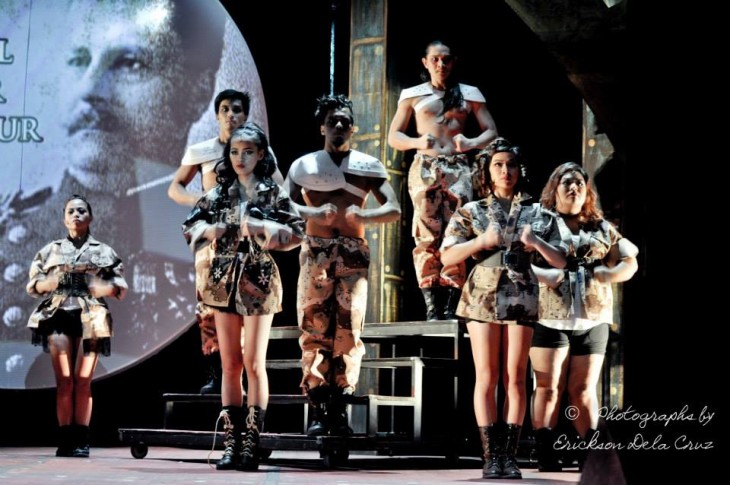
Aside from the cast’s portrayal, Mabining Mandirigma had more surprises with the way that they connected history to modern times. The song number “Viva La Republica Y Mabini,” where they celebrate the new republic of the Philippines, ended with an entertaining cast pictorial done in an almost vaudeville-like manner. After all the old-fashioned picture-taking, Aguinaldo suddenly took out a selfie stick and the entire group posed for a selfie, including a reluctant Mabini. “A history lesson for the selfie generation,” as Director Millado said indeed.
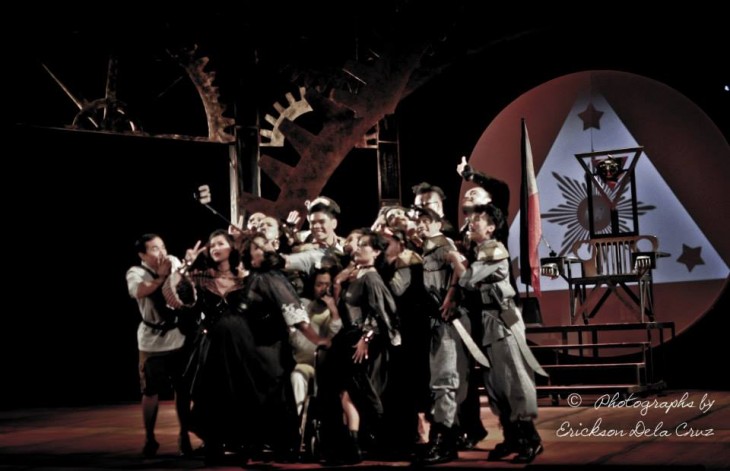
Another surprising performance that worked was when the theater was plunged into total darkness, only to be lit up by the cast holding flashlights, and wearing all-white clothes. Also, at the end, after Mabini’s death, the cast came out in modern outfits, complete with jeans, sneakers, and hoodies. Each one talked about the outcome of his or her character, and the way the character impacted Philippine society (the ilustrados said their characters are still present today, in the members of congress who accumulate money through their pork barrel, for example). The cast ended by singing “Mahalin ang Pilipinas nang higit sa iyong sarili,” spreading good vibes as well as inspiration to all present.
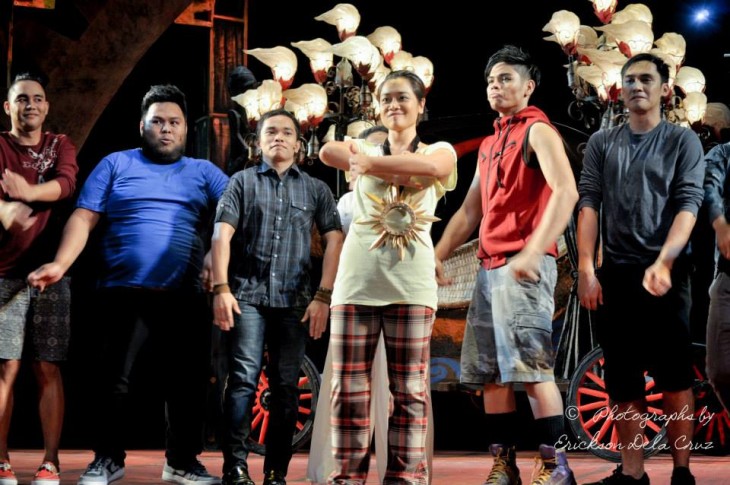
Overall, Mabining Mandirigma will leave one awestruck, entertained, and inspired by performances, songs, and the message, making audiences want to relearn about Mabini and Philippine history, and even raring to watch the musical all over again.
Catch Mabining Mandirigma’s last two weekends this July at CCP’s Tanghalang Aurelio Tolentino (Little Theater). They have shows from July 10 to 19, Fridays to Sundays. Performances are at 3PM (Matinee) and 8PM (Gala). Tickets are available at Ticketworld.com.ph.
Photos by Erickson Dela Cruz courtesy of Tanghalang Pilipino.
What's Your Reaction?
Dark chocolate, dogs, and adventure are just some of Mel's passions. Aside from doing her best to live life to the full, she plans on writing her own fiction one day.

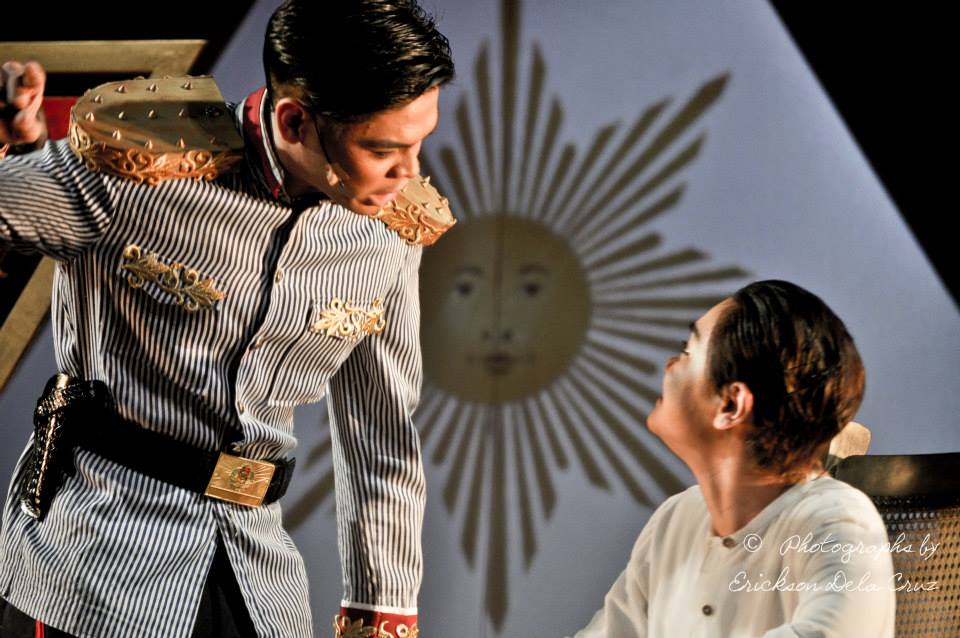
Great show, but extremely bad history on the part of the historians or writers of the show. It is misleading, unfair and innacurate to state that:
*After some decisions over which Aguinaldo and Mabini disagree, with Aguinaldo siding with the ilustrados and eventually accepting autonomy under American rule..*
Mabini disagreed with Aguinaldo in declaring Independence on June 12, a move by Aguinaldo that history has proved him right. Mabini never even participated or supported the 1896 Philippine Revolution. The notion that Aguinaldo eventually accepted autonomy under American rule without including in the statement that Aguinaldo fought the United States for three years, with most of it through Guerilla Warfare where Aguinaldo`s leadership proved effective and backed with widespread support: striking the first major blow against US Imperialism.
Aguinaldo was captured through a cowardly and dishonorable act by the Americans disguised as POWs, and only after 9 days as a prisoner of war, did Aguinaldo decide to play the game of the new invaders- to wage his own AMIGO Warfare as the quickest path to Indpenedence. His true intentions are revealed by refusing to learn any English and re-building his house to honor the flag and the revolution of 1898 as a supreme and lasting protest towards American rule. He began that project after the Sedition Act or Flag Law of 1904-1919 was lifted by the colonizers. That law made it a crime punishable by death to display the Philippine Flag and sing the national anthem which he commissioned.
*Aguinaldo, by association with the Philippine Republic, had to be discredited. The Americans had to not only consolidate power in the archipelago, but substantiate the military takeover of a nation on the other side of the world. What better way to present their ‘benevolent assimilation’ policies that through careful character assassination of the Filipino’s leader.
That is one part of the equation. The other is far more complex and difficult to consider. Most tellingly, much of our understanding of the Philippine Republic and Aguinaldo comes from Mabini. A brilliant man, there is no doubt, who was a patriot unparalleled in our annals. He was also a bitter man, broken in part by the failures of the Republic. Who fervently believed that if he was heeded more, failure would not have been an eventuality. Maybe he was right. But, that bitterness, that anger at the fall of the Republic, colored his subsequent writings. Not to mention the fact that he spent part of the remainder of his life in exile. The Mabini/Aguinaldo relationship was complex. And Mabini began as one of the leading powers behind the Philippine Republic. Eventually though, his influence waned. He lost the power struggle to sit at the right hand of Aguinaldo. He was, understandably, angry. Anyone would have been. But, in evaluating and understanding what he wrote, we also have to understand why he was writing it and what he was feeling at the time.*
http://iwriteasiwrite.tumblr.com/post/4041919704/aguinaldo-in-perspective
Approximately how long was the theater play?